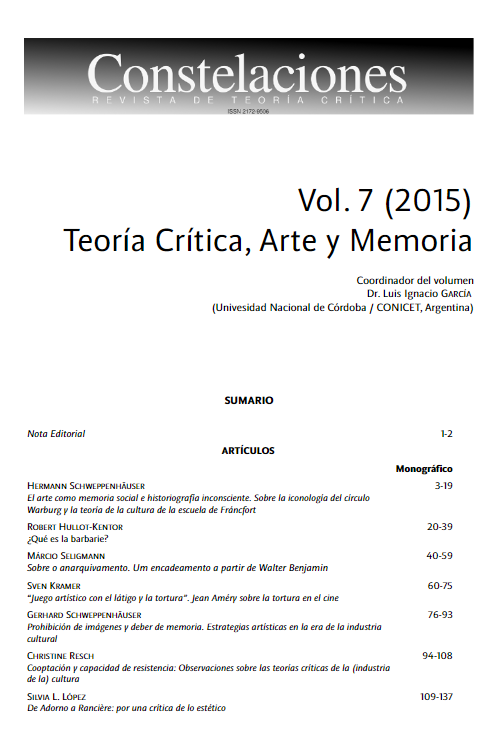On the Mattering of Silence and Avowal: Joseph Beuys’ Plight and Negative Presentation in Post-1945 Visual Art
Keywords:
Joseph Beuys, Silence, Auschwitz, Theodor W. Adono, negative presentationAbstract
Joseph Beuys’ installation Plight (1985) forcefully avows of the Nazi genocide by means of negative presentation. The work culminates a collective artistic investi-gation of negative sculptural strategies for representing traumatic history, opened by the Nouveaux Réalistes under the impact of Alain Resnais’ documentary film Nuit et Brouillard. This article outlines this history and analyzes Plight in the context of the ‘after Auschwitz’ crisis of representation and traditional culture theorized by Theodor W. Adorno. For Adorno, Auschwitz demonstrated threats to autonomous subjectivity posed by tendencies unfolding within the global social process of modernity itself. Reflecting on the fate of music, poetry and literature under these conditions, Adorno advocated a hermetic art of silence and dissonance, as exemplified by Paul Celan and above all Samuel Beckett. This article shows that in the visual arts, too, the genocidal violence of World War II was confronted with analogous strategies of indirection. In Plight, Beuys would successfully synthesize John Cage’s symbolic demolitions of traditional music and the investigations of negative presentation carried out in sculpture by Arman and Daniel Spoerri.Downloads
Downloads
Published
How to Cite
Issue
Section
License
Authors who have publications with this journal accept the following terms:
1. Authors will retain their copyright and grant the journal the right of first publication of their work, which will be simultaneously subject to the License of recognition of Creative Commons CC BY-NC-SA 4.0 that allows third parties to share, redistribute and adapt the work provided it is for non-commercial purposes and its author and first publication in this journal is indicated.
2. Authors may adopt other non-exclusive distribution license agreements for the version of the published work (e.g., depositing it in an institutional electronic archive or publishing it in a monographic volume) provided that the initial publication in this journal is indicated.
3. Authors are permitted and encouraged to disseminate their work via the Internet (e.g., in institutional telematic archives or on their website) before and during the submission process, which can produce interesting exchanges and increase citations of the published work. (See The Effect of Open Access).
Data confidentiality
1. Constelaciones. Revista de Teoría Crítica guarantees that the data you send us will only be used to meet the requests made in this message.
2. Your data will not be passed on to third parties.
3. You may request that your data be removed from our records at any time.





